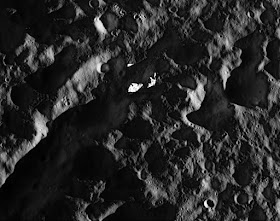At lower right is the large, multi-ringed impact basin named Evander, which is about 220 miles wide. The canyons of Padua Chasma, features that form part of Dione's bright, wispy terrain, reach into the darkness at left.
 |
 |
| Cassini captured an oblique view of Dione's heavily cratered landscape. |
 |
| A striking image of Dione hanging in front of Saturn's rings. |
 |
| Dione against a backdrop of Saturn's atmosphere. Notice the thin line of Saturn's rings behind the moon, and the shadow of those rings below. |
 |
| A departing view of Dione. |
| Dione against colorful Saturn. Image taken in 2005. |
 |
| Dione and Rings. Image taken earlier in 2015. |
 |
| Towering cliffs dominate Dione's trailing hemisphere. The cliffs and chasms are possibly caused by tidal stresses over time. Image taken earlier in 2015. |
Dione is smaller than Earth's Moon, and is Saturn's fourth largest. It is made of water ice and rock. It's leading hemisphere is heavily cratered, and it's trailing hemisphere is less cratered and marked by bright ice cliffs, originally characterized as "wispy terrain" by Voyager scientists, until Cassini close up images revealed their true nature.
 |
| Image Credit: Wikipedia Commons. |
 |
| Saturn in the southwest shortly after sunset. Image Credit: Me and Stellarium |
Good luck finding Saturn in the night sky. Remember, you can always learn what's up in the night sky by visiting the Dome Planetarium at the Peoria Riverfront Museum.

No comments:
Post a Comment